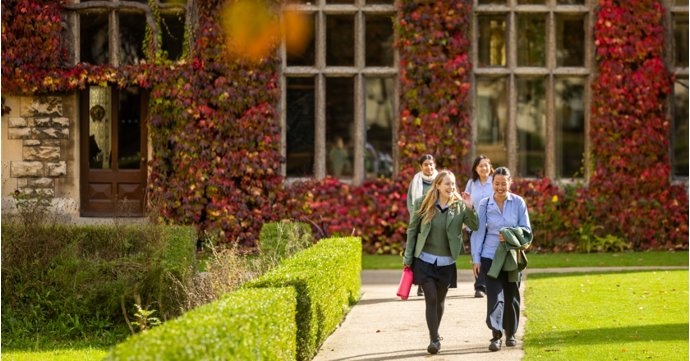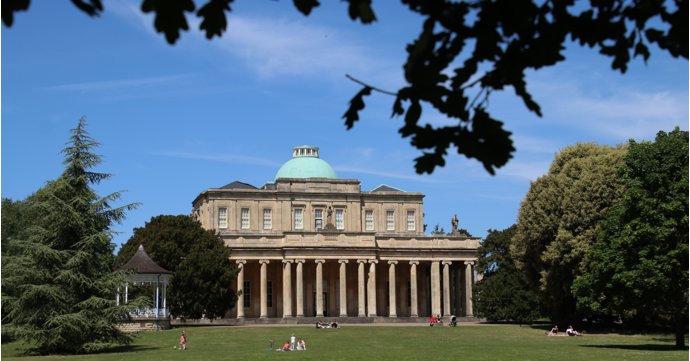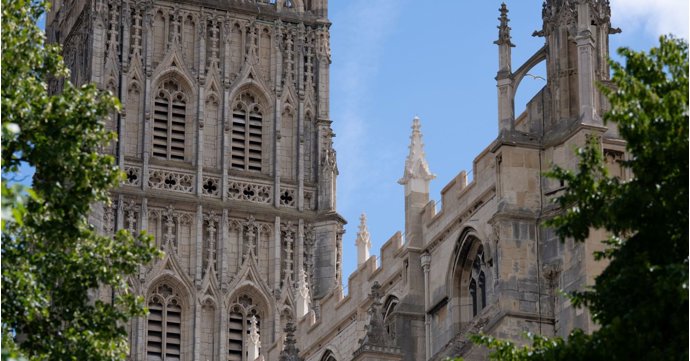From beloved children's books to Victorian horror stories that are still scaring readers to this day, Gloucestershire has been inspiring authors for hundreds of years.
In this hot list, SoGlos's resident bookworms round up 10 literary legends from the county, spanning magical mice, fearsome pirates and ghastly ghosts...
Dick Whittington
While people in Gloucestershire may be more familiar with the pantomime Dick Whittington and His Cat, the story was inspired by a real man who lived between 1358 and 1423. Born to a wealthy Gloucestershire family, Richard Whittington travelled to London and trained to become a mercer, trading fabrics to the rich and famous of the city, including the royal family. Through his royal connections, he made his way into politics and proved popular with voters, too, as he served as Lord Mayor of London four times. He died without an heir, so his considerable fortune was left to the people of London.
The folk story tells it slightly differently, with Whittington being born poor and travelling to London to make his fortune. Working for a wealthy man, when the opportunity to acquire a stake in a cargo ship presented itself, all he had to wager was his cat. Poor, lonely and bullied out of his home, Dick ran away, but was stopped in his tracks by the Bow Bells chiming, 'turn again Whittington, thrice Lord Mayor of London!' On returning to his employer's home, he found his fortunes changed. The ship arrived at its destination overrun with rats, which Dick's faithful feline made quick work of, making him and his fellow investors a fortune and leading him to his position as Lord Mayor — just as the bells said.
The story has become the stuff of legend as one of England's most famous folk tales, with a puppet show version of it mentioned in The Diary of Samuel Pepys from 1668 — though the original 'boy and his cat' tale is thought to date back to medieval Persia.
Ebenezer Scrooge
While Charles Dickens is more closely associated with Rochester in Kent, Gloucester has its own claim to one of his characters — the infamous Ebenezer Scrooge from A Christmas Carol. While nobody can be sure how true it is, there's a theory that Scrooge is based on a banker called Jemmy Wood, who had the rather unfortunate nickname the 'Gloucester Miser'.
Despite amassing a fortune which equated to tens of millions in today's money, Wood wore the same clothes every day, walked everywhere instead of taking carriages and collected stray bits of coal that had fallen from the ships on the docks, so he didn't have to buy his own.
He was a sheriff and alderman of the city, but his name doesn't feature in the records of city benefactors from the time — it's even said when he died and was buried at St Mary de Crypt, the people of Gloucester celebrated in the streets because they wouldn't have to pay back their loans!
The Woman in Black
Paranormal investigators have theorised that The Woman in Black, the titular character from Susan Hill's terrifying story, may actually have been based on a real ghost story from Cheltenham. If you believe in the supernatural, it's said that the 'Morton Ghost' haunted a house which still stands to this day on the corner of Pittville Circus Road and All Saints Road.
Resident Rosina Despard recorded sightings of the apparition in 1882, when she was 19 years old. The ghostly figure was wearing a Victorian mourning dress with her face partially covered by a veil or a handkerchief. These sightings continued until 1889 and were corroborated by servants and neighbours, who had seen the apparition even in broad daylight, sometimes mistaking her for a living person. Some believed her to be the spectre of Imogen Swinhoe, a former resident of the property, who had a somewhat scandalous reputation as a drunk.
Subsequent sightings of the woman in black have been reported even as recently as the 1980s, with Hill's now iconic story being published in 1983.
The Tailor of Gloucester
Much-loved by children and adults alike, Beatrix Potter's The Tailor of Gloucester is one of the most famous stories inspired by the city. No. 9 College Court in Gloucester — which is now a museum and gift shop dedicated to the author and her work — is the setting for the story, where the mice help the tailor out by sewing a waistcoat overnight, after he saved them from his cat.
According to the museum, it's based on a true story, too. Potter's cousin told her the tale of Gloucester tailor, John Pritchard, who after closing his shop on Friday night leaving a waistcoat cut out but not sewn together, returned on Monday morning to find the garment almost completed, save for one button hole, with a note saying 'no more twist' pinned to it. He was convinced it had been done by fairies. Potter was so enamoured by the story, she insisted on visiting Pritchard's shop in Gloucester — which was on Westgate Street — and sketched a variety of buildings, including College Court, during her trip.
As well as setting foot inside the building that features in the story, visitors to The House of The Tailor of Gloucester will feel like they've stepped into the book itself, with the interior modelled on Potter's drawings of the Tailor's kitchen, complete with Simpkin the cat!
The Doors of Durin
Tolkien fans have been making pilgrimages to St Edward's Church in Stow-on-the-Wold to command the 'Gate of the Elves, open now for me' for years. Built more than 300 years ago, the church's north door is flanked by two ancient yew trees with a lantern suspended above and is said to have inspired the door to the Dwarven kingdom of Khazad-dûm, later known as Moria.
Apparently Stow-on-the-Wold was one of J.R.R. Tolkien's favourite places to visit during his time teaching Old English at Merton College in Oxford. St Edward's Church wasn't the only place to inspire the author either, with The Bell Inn in Moreton-in-Marsh claiming to be his inspiration for Gandalf's favourite watering hole, The Prancing Pony.
Even if you've not read Lord of the Rings, the church door is a spectacular site — and one of the country's most famous doors, alongside the Bank of England and 10 Downing Street.
Long John Silver
Many literature fans will know the name William Ernest Henley for his powerful poem Invictus. But what they may not realise is that the Gloucester-born poet was also the inspiration for the legendary literary pirate, Long John Silver.
Henley was good friends with Robert Louis Stevenson, with legend having it that Henley's distinctive appearance inspired the character. Despite having had his left leg amputated as a child, Henley apparently exuded masculinity, with a bushy beard and haughty laugh.
Stevenson wrote to his friend shortly after the publication of Treasure Island to confess 'it was the sight of your maimed strength and masterfulness that begot Long John Silver… The idea of the maimed man, ruling and dreaded by the sound, was entirely taken from you.'
Humpty Dumpty
Everyone knows that Humpty Dumpty is an egg, right? Well, not according to Gloucester folklore! The famous nursery rhyme is thought to have been inspired by a cumbersome cannon used during the English Civil War instead.
The cannon has been linked to both the Siege of Colchester and the Siege of Gloucester. In Colchester, the device was placed on the city's walls to defend it from the attacking Parliamentarians. That was, until they fired a cannon at the wall and Humpty Dumpty took a big fall, leaving the Royalists unable to put it back together and ultimately leading to victory for the attackers. At the Siege of Gloucester, on the other hand, it's believed that the Parliamentarians captured the devices from the Royalists and took them into the city as trophies when the siege was lifted.
Humpty Dumpty's depiction as an egg is first seen in Lewis Carroll's Through The Looking Glass, where Alice meets 'Humpty Dumpty himself' in chapter six.
Rosalind Buckland
Transporting readers to the bucolic idyll of the Slad Valley during World War I, Laurie Lee's Cider With Rosie is one of English literature's most well-read and well-loved stories.
The partly-autobiographical story is set against a backdrop of rolling Cotswold countryside, with Lee's mother taking centre stage and the author looking fondly back on the times that shaped his childhood. The rich, luscious descriptions of the landscape and wholesome story are also thought to have inspired H.E. Bates' Larkin books. The eponymous Rosie was actually based on Lee's cousin by marriage, Rosalind Buckland — something which she kept secret for 25 years.
Visitors to The Woolpack Inn in Slad can still enjoy a pint in Lee's local, with his grave located nearby for anyone wanting to pay a tribute, too.
Deepdean School
Younger readers may recognise Deepdean School for Girls from Robin Stevens' hugely popular Murder Most Unladylike book series.
The author is a Cheltenham Ladies' College alumnus, with the historic school providing plenty of inspiration for her novels — from the gym where Miss Bell supposedly 'fell' from the balcony in the first book, to the secret underground tunnel where Daisy and Hazel get stuck with a murderer in Jolly Foul Play.
Members of the Detective Society even have the chance to explore the inspiring building, as Cheltenham Ladies' College often runs Murder Most Unladylike-themed tours during its annual Heritage Open Days.
The Scowles
As well as serving as inspiration for Tolkien's Middle Earth, the Forest of Dean also famously inspired JK Rowling's Harry Potter novels. With the author growing up in Gloucestershire, it's no surprise that the area's magical landscape, which features iron ore deposits called 'scowles', fired up her imagination.
According to fans, Hagrid was supposedly born in the Forest of Dean — and the area was also Hermione's childhood holiday destination, which is what led the three heroes back to the area to look for the Horcrux in Harry Potter and the Deathly Hallows.
The area also served as a filming location when the books were turned into movies, with the gnarled trees and mossy groves of Puzzlewood and the famous horseshoe bend in the River Wye near Symonds Yat both featuring in Harry Potter and the Deathly Hallows Part 1.





















